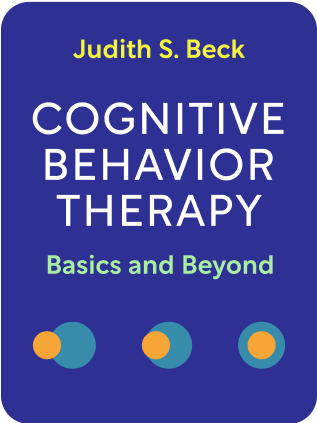

This article is an excerpt from the Shortform book guide to "Cognitive Behavior Therapy: Basics and Beyond" by Judith S. Beck. Shortform has the world's best summaries and analyses of books you should be reading.
Like this article? Sign up for a free trial here .
What are negative automatic thoughts? How can you correct them?
Negative automatic thoughts are the unhelpful or even harmful thoughts you have automatically in response to an event, situation, or stressor. Your immediate thoughts will often reveal underlying problems about your thinking which can be resolved through CBT exercises.
Read this article for more about negative automatic thoughts.
What are Negative Automatic Thoughts?
Negative automatic thoughts arise unconsciously, often in response to a situation and sometimes unprompted. For example, someone who has a core belief that she’s incompetent may be told that her manager wants to meet with her. Her negative automatic thought might be, “My boss probably thinks I’m doing a terrible job. I’m finally going to be found out and fired.”
Patients are often more aware of the emotion they feel than the thought itself. Automatic thoughts may come in the form of verbal thoughts or images.
A wide variety of situations can evoke negative automatic thoughts:
- External events
- “A friend didn’t pick up my call.”
- Stream of thoughts
- A patient thinks about an exam and how much is being tested, then continues thinking about how important her grades are and a cavalcade of other thoughts.
- Cognition: a thought, image, memory, or daydream
- A patient thinks of a violent image.
- A patient has a flashback of a traumatic event.
- Emotion
- A patient feels anger, then reflects on that anger. “I shouldn’t be angry at him. I’m such a bad person.”
- Behavior
- A patient binge eats despite promising herself she wouldn’t. “I’m so weak. I can’t even get my eating under control.”
- Physiological
- A patient feels her rapid heartbeat. “Why is my heart racing so fast? There’s something seriously wrong with me.”
- Mental experience
- A patient feels a sense of unreality. “I’m going crazy.”
These automatic thoughts then lead to emotions. The two are distinct.
- Emotions are one word: sad, anxious, angry, jealous, ashamed, hurt, suspicious, disappointed.
- Automatic thoughts are expressed as more than one word.
Identifying Negative Automatic Thoughts
A key part of treating mood disorders is identifying the patient’s automatic thoughts and guiding the patient to evaluate them and overcome them. This is done by:
- Articulating the automatic thought explicitly.
- Evaluating the automatic thought for validity and utility.
- Constructing behavioral experiments to highlight the discrepancy between the patient’s automatic thoughts and reality.
The key question of identifying automatic thoughts is: “What is going through your mind right now?”
To elicit the automatic thought, try a range of techniques:
- Paint a vivid picture. Ask the patient to imagine the situation, picture the time, and revisit exactly what the patient was doing.
- Ask for a description of the physical sensation of the emotion.
- “Where did you feel the anxiety?”
- Turn the reflection into present tense—past tense obscures the emotional response.
- Ask the opposite of what you think the thought was. “Did you think you were going to ace the test?”
- Role play the situation with the patient.
- If the patient is unresponsive, ask what the patient thought would have been the worst that could have happened.
- “Were you imagining something that might happen or remembering something that did?”
The patient should be led to describe the specific thought as it occurred, NOT speculating on its intent.
- Not “I must be sabotaging myself.” Rather “I was thinking, “I’m going to fail the test.”
- Not “I couldn’t get myself to start reading.” Rather “I can’t do this.”
- Not “how will I get through it?” Rather “I can’t get through this.”
Probe if secondary automatic thoughts may have surfaced.
- Automatic thoughts about their reactions (emotion, behavior, or physiology) can cause a vicious cycle.
- For example, the first thought may be “I’m going to fail the test.” This may provoke anxiety, leading to a physiological response and rapid heart rate. This may then provoke another automatic thought: “Why is my heart beating so fast? What’s wrong with me?”
- Ask, “what else went through your mind?” Then ask, “which of these thoughts was most upsetting?”
Frame the thought as an idea, not as a truth or fact. It will be evaluated later.
Make clear the impact the thought has on emotion and behavior.
- “How did that thought make you feel?”
- “What does that emotion make you want to do?”
- “What would happen if you had the opposite thought? How would you feel?”
- The patient should understand the difference between thought and emotion. Emotions are one word.
If the emotion doesn’t match the thought, then probe further—you may not be at the root of the situation. Here’s an example:
- “My mom didn’t pick up the phone and I thought ‘what if something happened to her?’ I felt sad.” This doesn’t quite match—wondering if something happened to your mother would typically provoke worry or anxiety.
- Probe further—“so the ring tone stops. What happens next?” Patient: “I get teary.” Therapist: “What is going through your head?” Patient: “What if something happens to her? Then there’s no one left to care about me.” That’s the real underlying thought that matches the emotion of sadness.
Rate the intensity of the emotion to triage problems and gauge improvement in mood.
- “Let’s try to rate the emotion on a scale of 0 to 100%. 0 is no sadness at all, and 100% is the saddest you have ever felt.”
- Make a ruler of emotions with the patient. “Let’s make a scale of when you felt sad in the past. When did you feel just a little bit sad? The saddest you’ve ever felt? And in between? Now, how did you feel in this situation?”
- If the patient is reviewing a past event: “How much did you feel [the negative emotion] then? How much do you feel it now?”
- Situations that are minor in emotional intensity might not be worth exploring further.
Correcting Negative Automatic Thoughts
Patients misconstrue neutral or even positive situations as negative through their automatic thoughts. Further, they tend to not examine their automatic thoughts critically and take them for granted. However, through the process of CBT, by examining their automatic thoughts and correcting errors, they often feel better.
Automatic thoughts can be examined on the basis of their validity and utility.
Validity: the thought is not supported by the evidence. Or, the conclusion drawn may be distorted.
- Example: The patient looks at evidence of failure and thinks, “I didn’t do what I promised,” which leads her to conclude, “I’m a bad person.” The patient can learn to recognize that the conclusion is incomplete and not supported by all available evidence.
Utility: the thought may be valid, but dysfunctional.
- Example: “It’ll take an all-nighter to finish this assignment.” While true, this increases the patient’s anxiety, which decreases concentration and causes worse performance. Therefore, this thought is dysfunctional.
- A better thought is, “I’ve finished assignments in this situation before. Dwelling on how long it’ll take makes me feel bad, and I won’t concentrate. It’ll take me longer to finish. Better to concentrate on one part at a time, and give myself credit for finishing.”
Automatic thoughts can be examined on the basis of their validity and utility. Invalid thoughts are not supported by the evidence. Or, the thought may be valid, but dysfunctional.
Never challenge a patient’s thought or belief. This violates the collaborative empiricism of CBT. You are to guide the patient to examining her own thought.
Ask Socratic questions to help them gain distance.
- “What is the evidence that your thought is true? What is the evidence on the other side?”
- “What is an alternative way of viewing this situation? What else could explain the person’s behavior/the outcome?”
- “What’s the worst that could happen? How would you cope with this situation?” (You can give solutions to help the thinking.)
- “What’s the best that could happen? What’s the most realistic outcome of this situation?” (This is especially useful if the patient has a catastrophic view.)
- “What is the effect of believing your automatic thought? What could be the effect of changing your thinking?”
- “If your friend were in this situation and had the same automatic thought, what advice would you give him or her?”
- “What should you do going forward? How likely are you to do this?”
For more advanced patients, you can vary the questions.
- “Is it true that [your extreme assumption] always has to be true?”
- For example, “does it always have to be true that you need to make your mom happy at all times?”
- “Is it reasonable to expect that sometimes [the situation] will happen?”
- “Is it desirable to have [this extreme goal]?”
Cognitive distortions tend to fit one or more of these patterns:
- Catastrophizing—imagining the worst possible thing that could happen
- Selective bias/tunnel vision/discounting the positive —focusing and emphasizing negative evidence for the thought. Alternatively, ignoring or de-emphasizing positive evidence against the thought.
- All-or-nothing—”either I get an A or you’re a total failure.”
- Mind reading—assuming negative intent or negative beliefs about other people, without considering other possibilities.
- Emotional reasoning—because you feel it so strongly, it must be true
- “I feel like a failure all the time, so it must be true.”
- Exaggeration, or overgeneralization.
- Should and must statements—a precise fixed idea of how people should behave. The patient overestimates how bad it is if these expectations are failed.
When automatic thoughts are true:
- Focus on problem solving.
- Investigate whether the patient has drawn an invalid conclusion.
- Work on acceptance.
Comforting lines to say:
- “We’ll keep practicing this until it becomes easy.”
- (If the patient finds it difficult to get thoughts) “Sometimes these thoughts are hard to catch. No big deal.”
Ask about the patient’s current mood and how much they believe the automatic thought.
If after examination, there is no mood improvement, a deeper root issue may be at hand.
- The automatic thought may be too superficial. Other thoughts, images, or assumptions remain.
- “I was thinking that I would fail the test” may be incomplete. On further examination, the patient says, “I was thinking I can’t do anything right. I saw my parents laughing at me.”
- Evaluation of the automatic thought is implausible, superficial, or inadequate.
- “Yes, my automatic thought was silly. I’ll get my work done for sure.”
- The patient has not sufficiently expressed the evidence in support of the automatic thought.
- Don’t skip ahead after one response. Ask if there’s any other evidence in support of the thought, or against the thought.
- The person believes the new thought rationally, but doesn’t feel it emotionally.This is often because of an underlying belief, which needs more intervention to change.
Teach the patient to examine thoughts herself. Often 1-2 particular questions will work better for a patient than other questions.
- Patients can keep a Thought Record or “Testing your Thoughts” worksheet, which goes through the whole Socratic questioning above. Components include:
- Date/Time
- Situation—”What event or stream of thoughts led to the unpleasant emotion? What distressing physical sensations did you have?”
- Automatic thoughts—”What thoughts or images went through your mind? How much did you believe each at the time?”
- Emotions—”What emotion(s) did you feel at the time? How intense was the emotion?”
- Adaptive response—”What cognitive distortion did you make? Use (Socratic) questions at bottom to compose a response to the automatic thought. How much do you believe each response?”
- Outcome—”How much do you now believe each automatic thought? What emotion do you feel now? How intense is the emotion? What will you do/what did you do?”
- Note to the patient that this is a general tool, that it may not work all the time, and that relieving the emotion by 10% is worth it.
- For some people, consider audio recordings of the main points, rather than written notes.
Not every thought needs to be examined. It might be more helpful to focus on a more distressing thought, teach other parts of the cognitive model, or avoid distress in the moment.
With experience, the patient can skip some of the examining questions, going directly to examining alternatives and forming an adaptive response.

———End of Preview———
Like what you just read? Read the rest of the world's best book summary and analysis of Judith S. Beck's "Cognitive Behavior Therapy: Basics and Beyond" at Shortform .
Here's what you'll find in our full Cognitive Behavior Therapy: Basics and Beyond summary :
- How to use CBT to overcome anxiety, sadness, anger, frustration, and stress
- How to address traumatic events earlier in your life, so that they have less hold on your thinking today
- The key ways to build rapport as a cognitive behavior therapist






